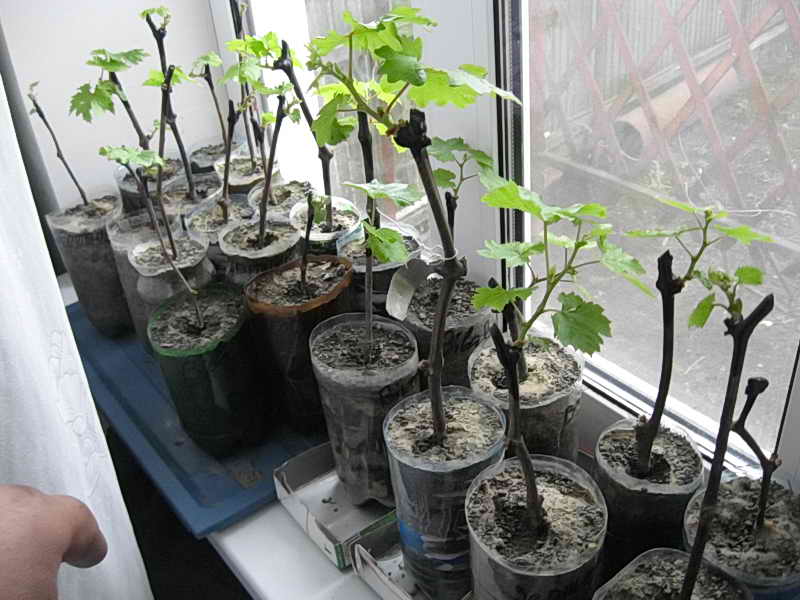
Germination of grape cuttings at home is a simple task, with a minimum of effort, even an inexperienced gardener will cope with it. Cuttings have many advantages, therefore, remains the most common method propagation of grapes.
There are several ways to germinate Chubuk, learning about the features of each of them, you can highlight the ideal option for yourself.
Content
What are the benefits of growing grapes from cuttings
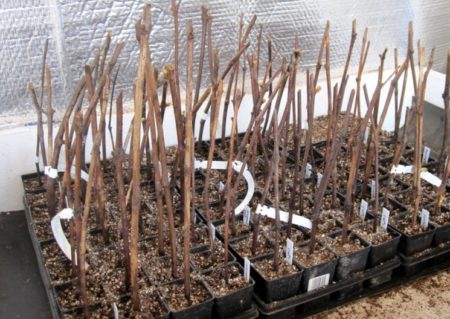
Are you familiar with a situation where neighbors grow incredibly tasty, productive grapes that you would love to plant at your place, but neither the name of the vineyard owner, nor you know the name? And what to do when the name of the variety is known, but you just can’t find it in the nurseries of your city, and are you afraid to order from catalogs? There is nothing easier than asking friends to share the shoot, grapes will not suffer from this, and you will save time and money!
Harvesting vines for cutting cuttings is carried out in the fall just during the planned pruning, it turns out that nothing needs to be thrown away. Several seedlings can be grown from the cuttings at once, if one is weak, there are several more to replace. Browse forums where growers exchange cuttings, send them by mail, and the prices for them, when compared with seedlings from nurseries are scanty.
Why germinate cuttings
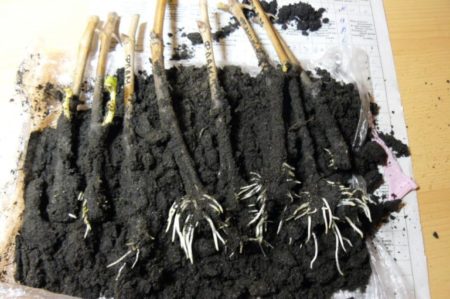
Grapes propagated by seeds, chubuki and layering. The first method takes a lot of time and does not guarantee a good result. Not all varieties retain varietal traits when grown from seed. The instillation of a young shoot from a bush for rooting is possible only in regions with early spring and warm summers. Cuttings can propagate grapes in areas with a cool climate, where there is a risk of late return frosts and short summers.
The moment of complete ripening of the vine falls in autumn (during leaf fall), then the growing season ends, the bush “falls asleep” for 2 or 2.5 months. Then the vineyard is preparing for the spring awakening. Harvested cuttings take root and begin to grow (buds open) back in February, which means that their growing season begins much earlier.
Early sprouting of Chubuk is an impetus to the development of grapes, while the plant forms very quickly. By the time of planting in the open ground, the sprouted branches will be full, fully prepared seedlings. By fall, they will have time to get stronger, get used to new conditions, gain strength before wintering, which will be the key to an earlier entry of grapes into the fruiting stage.
Harvesting and storage of cuttings
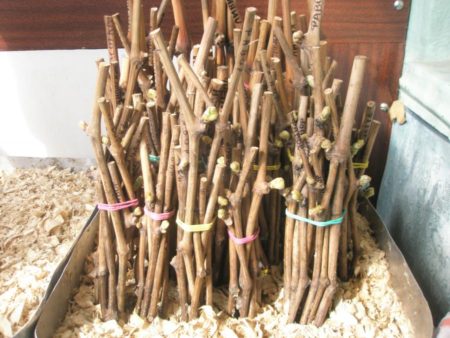
By the end of autumn, when you need to cut the cuttings, the shoots have ripened and absorbed all the necessary substances for better germination. The vine is taken from the top of the crown of a strong, healthy bush, showing good yield. Sharp garden tools are prepared for work, they must be cleaned and disinfected.A good stalk looks like this:
- bark greenish-brown without spots, rot and cracks, the incision is light green;
- stalk smooth without pronounced nodes, about 8 mm thick with 4–8 buds;
- the optimal length of the handle is from 20 to 35 centimeters.
Before sending to twig storage They are divided into separate varieties so as not to get confused later. Several cuttings are tied with a rope or elastic band, the name of the variety can be written with a marker or felt-tip pen directly on the stalks (do not damage the bark), but it is better to make notes on pieces of paper and attach labels to each bundle. Storage Methods:
- on the street in the ground (in deep holes) - a good method, however, they sprout twigs in February, and the land during this period is not particularly amenable to digging;
- in the basement or on the loggia (15–19 degrees) - bundles are placed in containers with moistened sand or sawdust. The vines can be folded in their entirety, and cut the cuttings already before germination. Before laying for storage, the branches are abundantly sprayed with 2% iron sulphate and thoroughly dried;
- in the refrigerator (0-6 degrees) - the bundles are wrapped in a moistened tissue, placed in a paper or plastic bag with small holes. Once a week, packages are shifted to the other side, humidity is checked, the branches on which mold is formed are thrown away.
To prevent the cuttings from drying out during storage, experienced growers are advised to use the waxing method. Paraffin from an ordinary candle is melted in a metal bowl on the stove; a small amount of garden varnish is added for plasticity. The mixture is cooled to a temperature of 75 degrees, the tops of the chubuk are lowered into it, while it is desirable to capture the upper kidney.
How to prepare and how to sprout grape cuttings
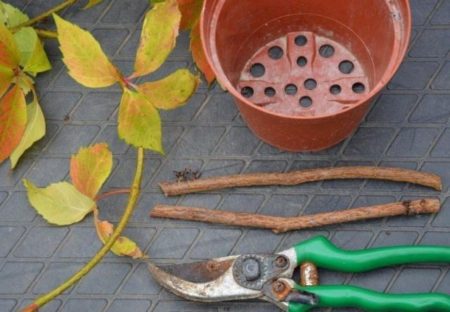
For the correct calculation of the start date of preparation of cuttings for rooting, rely on the period of planting of grapes in a constant place. Landing is carried out when the return frosts pass. Most often, rooting takes 20 days, so storage in the winter and germination in the spring is the best option. In some varieties, rooting takes about 6 weeks. How to prepare cuttings:
- since the first half of February, the Chubuki have been taken out of the storehouse and thrown away all damaged and dried specimens;
- whole branches are dipped in melt water and left for 48 hours. Once a day, the fluid is updated;
- the next step is disinfection. Chubuki for a couple of seconds is placed in a three percent solution of copper sulfate;
- the tips of the cuttings are soaked in Kornevin for one day (the solution is prepared according to the instructions). You can mix part of aloe juice with two parts of water;
- no more than three buds are left on each branch. The upper cut (flat) is made about one and a half centimeter above the knot, and the lower one is led obliquely under the knot (towards the eye).
Heat and moisture are all that the cuttings require for good germination. Usually the first to wake up the kidneys and only then grow the roots. We would like it to be the other way around, for this we need to create a warmer environment where the tips of the shoots will be located. There are many ways to germinate in the arsenal of experienced gardeners, but the most popular are wilderness and aging in water.
Germination of grape cuttings in water
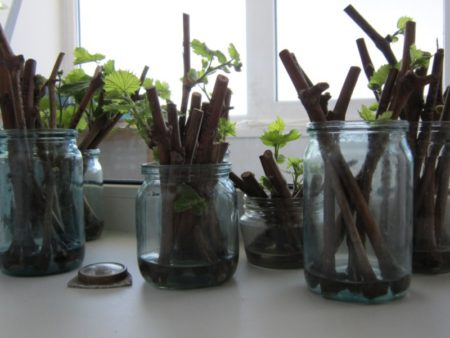
In the process, you need to carefully monitor the temperature of the water, you must not allow overheating above 26 degrees, there is a risk of decay.It may be cold on the window, shoots under such conditions will germinate slowly, a sheet of foam should be placed under the container. It is good if a central heating battery is located on the windowsill, if not, an electric heater can be supplied. How to germinate:
- the lower kidney is cut off, then the cuttings are placed in glasses or jars;
- about three centimeters of water are poured, subsequently poured to the previous level;
- containers with chubs are placed on a warm, well-lit window sill, if there is not enough natural light, lamps are installed;
- change old water to fresh every 3 days. If the liquid becomes turbid faster, it is updated every day.
The bottom of the container can be covered with a three-centimeter layer of cotton, covered with gauze so that the cuttings do not let the roots directly into the cotton. The laid "pillow" is moisturized abundantly so that water does not cover the cotton, but the material has always been wet. The buds will begin to sprout in 9–15 days, and after 5–7 days, the roots will hatch as soon as they grow to 3 mm, the cuttings are grown as seedlings.
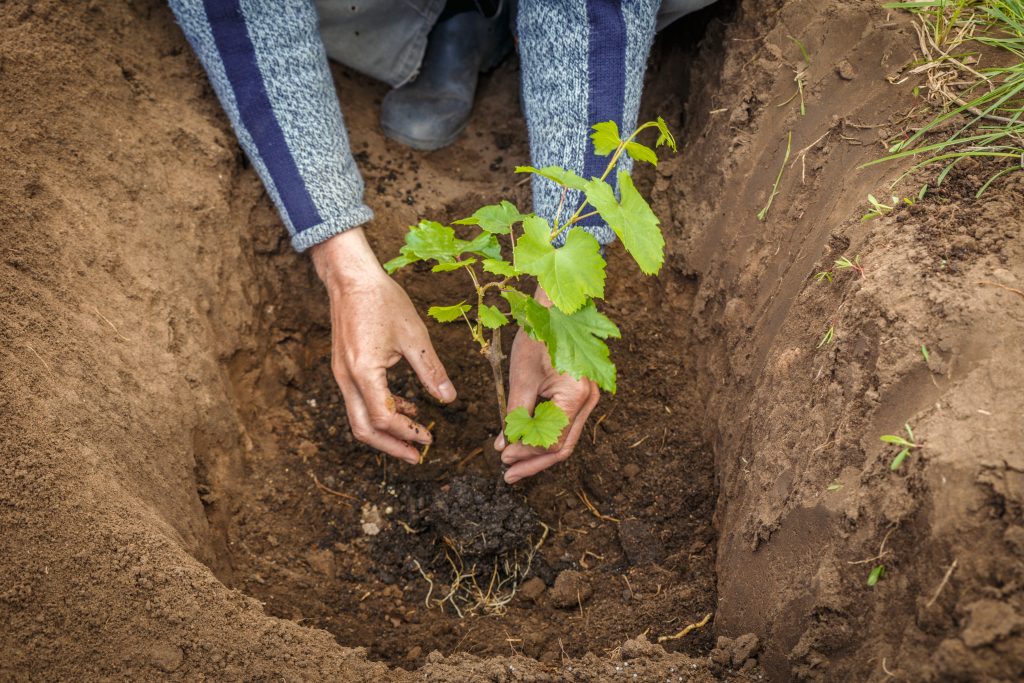
Where is better and how to plant grapes on the site
If you plan to grow grapes in the country, get ready for the fact that you have to work hard and read a lot ....
Germination in the substrate
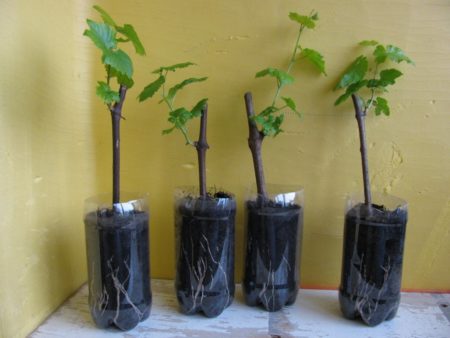
In other words, kilchivka, its meaning is to increase the temperature at the ends of the nibs, which contributes to the rapid formation of roots. Experienced wine growers construct intricate electrical appliances, and it will be easier for a newcomer to make a kilchevator from a plastic bottle. The device is very simple, does not require special skills:
- the neck of a plastic bottle is cut off;
- several drainage holes are made at the bottom, a two-centimeter layer of drainage material is laid;
- a mixture of earth with sand and rotted sawdust scalded with boiling water is poured into a bottle (1: 1: 1);
- the stalk is placed with the ground at a slight slope so that the eye remaining on the surface looks straight up;
- a kind of greenhouse (a plastic bag or a plastic cup) is built above the stem, placed in a place where the temperature does not drop below 20 degrees and does not rise above 26;
- the soil is always kept moderately moist; you need to water it carefully, it is better to add water to the stand;
- as soon as the shoot appears, remove the cup, first for 15–20 minutes and gradually increase the time.
Planting grape cuttings in glasses or pots
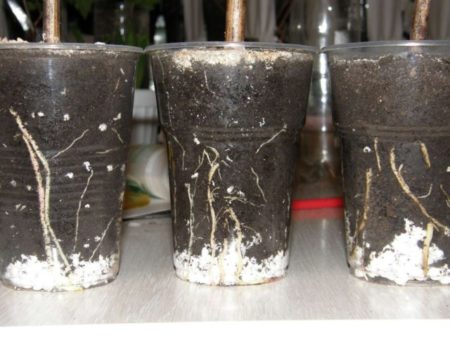
The container can be made of plastic and cardboard, clay and ceramic products are better not to use. Cardboard is preferable, rooted chubuki will not need to be taken out of the tanks when disembarking, over time, the cardboard will decompose in the ground. There are 2 methods, the first is no different from germination in bottles (with soil mix), and the second is more complex:
- several small holes are made in the bottom, a small layer of a mixture of earth with humus is poured;
- put another smaller container on the layer, fill it with sand;
- the chubuk is placed in sand, watered, covered with a transparent bag or a plastic cup. Sand periodically moisten.
The second method has its advantages, its secret is that the humus layer not only serves as food for the cuttings, but also protects it from the cold. The process of decomposition of organics is accompanied by an increase in temperature, the fertilizer helps to maintain the heat necessary for root sprouting. To maintain the optimum temperature, the glasses are wrapped in several layers of polyethylene (preferably dark).
Puzenko's technique and germination in peat tablets
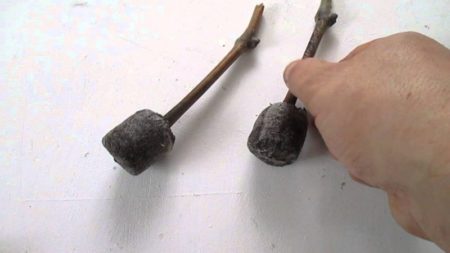
If desired, cuttings can be sprouted anywhere, for example, on the kitchen shelf or on the cabinet (Puzenko method). The tips of prepared chubuk are wrapped in a damp cloth, the wrapped part is placed in a bag, bandaged.The tops are left free, when placed on a cabinet they are turned to the light. After 15-20 days, when the roots grow back, the cuttings are transplanted into the ground.
The strongest roots are obtained by planting grape cuttings in peat tablets. The substrate does not require frequent hydration, the kidneys do not bloom, the main emphasis is on the roots. Pills are filled with water according to the instructions, plant stems in them, wrapped in cling film. Sprigs with peat are placed on the cabinet so that the tops are turned towards the window or lamp. It takes about 20 days to root, after which the cuttings are transplanted into the ground together with a “pot” (without a film).
Rooting in a pit or in the ground
The method is suitable only for the southern regions, frost-resistant varieties should be selected. In the spring, before the start of the growing season, the vine is cut a little longer than half a meter. They form a ring from it (with several turns), tie it with wire, and plant it in a deep hole. The earth is filled up so that no more than two kidneys are left on top. By the end of autumn, the branch will take root well, for the next season it will delight the first berries.
Plant cuttings without roots in the open ground is possible in early summer. An elevated, sunny place is chosen, the earth is loosened, humus and fine-grained vermiculite are added to it. Short cuttings are planted at right angles, and long (more than 30 centimeters) with a slight slope. The topsoil should always be a little moist, but you can’t bring it to waterlogging. The survival rate with this method is weak, plant several shoots at once.
Growing cuttings at home after rooting
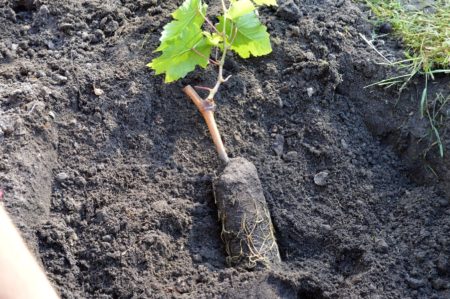
Cuttings that have already formed roots are immediately transplanted into containers with the ground, where they will grow until spring planting. The container volume should be from 500 ml to a liter, it is possible a little more, holes are made in the bottom and a drainage layer is laid. The soil mixture can be made from turf soil, sand and a mixture of sawdust, crushed dry foliage and organic matter (1: 2: 1). Some winegrowers take ordinary garden land.
When planting cuttings, be careful not to damage the roots. After transplanting, Chubuki watered abundantly, it is advisable to pinch the tops of the shoots a little. Containers with seedlings are placed on the windowsills, periodically watered, as soon as the hardening starts on the street, they begin to harden. If the house is warmly moisturized once a week, if it's cold - once every 15–20 days. As containers, you can use plastic bottles, how to properly transplant, find out from the video.
How to understand that cuttings are ready for planting in the ground
When germinating cuttings in water or according to the Puzenko method, it is immediately evident whether they gave roots or not. If the roots have grown to 2 or 3 mm, it means that the seedling will definitely take root during growing. In the case when the rooting took place in the soil or substrate, the roots are not visible, the Chubuk is slightly supported, if resistance is felt, then the roots of the branch. Usually, after rooting, the buds open and rather large leaves appear. Landing in open ground should be carried out when the weather is stable and stable (at least 19 degrees).
Reviews
Anatoly
We do not grow anything in the purchased land and do not recommend it to others; make the seedling mix yourself. During rooting, it is impossible to rearrange the cuttings from one place to another and to allow drafts in the room. Hardening before planting grapes must be carried out, a sharp change of scenery can lead to the death of a seedling. I cut the cuttings in the fall, I store preparations for germination on a glazed balcony, I spend germination in late January.
Margarita
I took a bunch of grapes from my neighbors and kept them in the refrigerator. When it came to rooting, she prepared twigs, but did not soak in the growth stimulator, the cuttings did not give roots. The following year, Chubuki, in preparation, put it for a day in a nutrient solution (1/4 teaspoon of honey per liter of water).3 weeks after planting in peat tablets, roots appeared, this spring I planted 2 bushes in the garden, now I am going to cover them for the winter.
Absolutely everyone can sprout grape cuttings at home. To avoid unpleasant surprises, harvest several branches at once, then a positive result will be guaranteed. Plant new grape varieties taken from your neighbors, update old bushes from your garden using the cuttings method, following our recommendations, you will surely succeed.

 Non-covering winter-hardy grape varieties for Moscow region
Non-covering winter-hardy grape varieties for Moscow region How to keep the vine in winter
How to keep the vine in winter When can I transfer grapes to another place in the fall
When can I transfer grapes to another place in the fall How to cover and prepare grapes for the winter in the suburbs
How to cover and prepare grapes for the winter in the suburbs